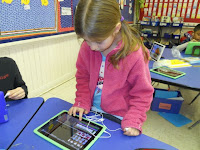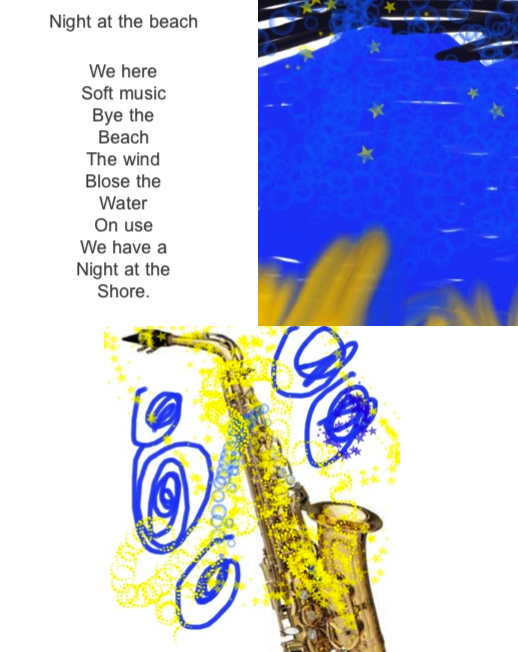 After spending two hours a day this week watching seventh graders fill in bubbles on our state's standardized test, I am finding myself thinking about assessment. Specifically, I am thinking about the many ways the iPad has enriched and strengthened our daily assessment practices -- and the value I see in authentic, embedded, process-rich assessment that informs and improves instruction. Technology like the iPad offers incredible ways to gather meaningful data that shows student thinking and creates a rich and detailed picture of learning. It can also make assessment more efficient, save teachers time, and open opportunities for more responsive teaching.
After spending two hours a day this week watching seventh graders fill in bubbles on our state's standardized test, I am finding myself thinking about assessment. Specifically, I am thinking about the many ways the iPad has enriched and strengthened our daily assessment practices -- and the value I see in authentic, embedded, process-rich assessment that informs and improves instruction. Technology like the iPad offers incredible ways to gather meaningful data that shows student thinking and creates a rich and detailed picture of learning. It can also make assessment more efficient, save teachers time, and open opportunities for more responsive teaching.Follow along as a public elementary school in Chicago integrates the iPad into its first through fifth grade classrooms.
Pages
Tuesday, February 28, 2012
Making assessment meaningful
 After spending two hours a day this week watching seventh graders fill in bubbles on our state's standardized test, I am finding myself thinking about assessment. Specifically, I am thinking about the many ways the iPad has enriched and strengthened our daily assessment practices -- and the value I see in authentic, embedded, process-rich assessment that informs and improves instruction. Technology like the iPad offers incredible ways to gather meaningful data that shows student thinking and creates a rich and detailed picture of learning. It can also make assessment more efficient, save teachers time, and open opportunities for more responsive teaching.
After spending two hours a day this week watching seventh graders fill in bubbles on our state's standardized test, I am finding myself thinking about assessment. Specifically, I am thinking about the many ways the iPad has enriched and strengthened our daily assessment practices -- and the value I see in authentic, embedded, process-rich assessment that informs and improves instruction. Technology like the iPad offers incredible ways to gather meaningful data that shows student thinking and creates a rich and detailed picture of learning. It can also make assessment more efficient, save teachers time, and open opportunities for more responsive teaching.Monday, February 27, 2012
Poetry Publishing on the iPads
We’re in the heart of our unit on poetry. My students have learned several strategies that poets use including repetition, onomatopoeia, alliteration, visual imagery and line breaks. This week a few students wanted to draft their poems on the iPad. We had not tried this before, so I decided to let my students “have a go.”
As I watched my students carefully, I tried to think about how this experience was different than writing or publishing on paper. I noticed two big things right away.
First, the concept of line breaks and how to use them effectively was evident when writing on the iPad. Planning line breaks and reworking them to fit in a handwritten poem is labor intensive for the average first grade student. When writing on the iPad, line breaks become easy to fix, move and manipulate. This results in line breaks that make an impact for both the reader and writer.
Second, kids were more likely to revise their drafts when working on the iPad. Similar to what I observed with line breaks, it was easy for kids to manipulate the text and change the layout without having to erase, rewrite and reorganize. Many times I saw my students write a few lines then share their work with a think partner. When the think partner would provide feedback, kids were more willing to use the feedback to enhance their poem because insertion or revision was a quick fix on the iPad. In previous writing attempts, I had not seen my students work so flexibly or be as open to feedback.
There were additional benefits to writing on the iPad including the ease of organization and diverse options for sharing. Not all students desired to draft on the iPad and that is perfectly fine by me. I want to provide my students many options for thinking, writing and sharing their work. I hope to create an environment where kids move seamlessly between tools, modalities and resources.
It seems as though the students who drafted on the iPad were inspired by this experience–many wrote multiple poems and 4 or 5 are creating an ePub anthologies. I’ll try to provide an update next week on Poetry Friday.
Thursday, February 2, 2012
Active Literacy With the iPad: Part 1
When I’m teaching reading, I’m teaching students how to be active readers. That means that they need to engage with what they are reading. They need to think, talk, and write. They need to leave tracks of their thinking. Students do this by writing post-it’s and annotating the text they are reading. (Depending on they type of text.)
When I first began exploring the iPad I was thrilled to learn that iBooks allows students to write notes and highlight things. Now they could have virtual post-it’s! What was even more exciting to me was that they could e-mail me these comments to me. Here’s an example of what one of these comment pages might look like.
 As
you can see, the comments come up but not the text that the student is
referring to. This can be fixed if the student highlights the sentence
or phrase that inspired that thought. This is what I plan on teaching
my students next. I think that it will be very powerful for them to
articulate specific words or phrases that have triggered their thinking.
As
you can see, the comments come up but not the text that the student is
referring to. This can be fixed if the student highlights the sentence
or phrase that inspired that thought. This is what I plan on teaching
my students next. I think that it will be very powerful for them to
articulate specific words or phrases that have triggered their thinking.I find this format really revealing and easy to look at as well as assess. I have enough rag tag stacks of paper and this document is a quick assessment glance at the thinking my student did during the day’s lesson. I also think that when these comments are listed out like this it makes it easy to look for patterns in thinking.
In the example above I see the student is demonstrating an emotional connection with the text, they are questioning, and they are linking to their background knowledge. The comment about Pandora reveals that the student is probably connecting to their background knowledge of the mythological person Pandora and when the article refers to Pandora as a place he is attempting to reconcile this information. This would be my opening point in a conference about the text.
So what’s the catch?
Well, the catch is that this only works with iBooks that you purchase…which I have no money for, and ePUBs. The good news is that there is a way to turn any internet article into an ePUB for students to use. Thanks to Bruce “Awesomeness” Ahlborn for this tip. dotEPUB is a site that will do this dirty work for you. All you have to do is install their bookmarklet on your computer or iPad and a few simple clicks will send the article to your device.
Bam! Presto! Any internet article becomes a tool for practicing active literacy.
Management Issues
I would suggest that you, the teacher, use dotePUB on your computer and then drop it into ibooks to sync to the devices. You can install this on student iPads easily so that they can do it themselves. However, itunes will sync all of the student articles off the devices and back on to all the other devices. Which means that you now get every single article that each student Epubbed. (Is that a verb? If not you heard it here first!) It's not a huge issue but a minor headache that you can avoid.
Wednesday, February 1, 2012
Here is our first collaborative art piece that will be put up for auction at a school fundraiser tomorrow. All of these pictures were taken in our classroom, with the exception of two. All of them were taken and edited by students with their iPads! I am very, very proud of their work. In fact I'm gong to have a hard time parting with this.
Happy Digital Learning Day!
A snapshot into our learning…
Last week my class followed the Caldecott Award announcement. We were thrilled to learn that a classroom favorite, A Ball for Daisy by Chris Raschka, won! My students wanted to celebrate this accomplishment. I decided this would be a great time to introduce book trailers.
I shared several exemplary trailers with my students. Then my class created a chart detailing the attributes of a terrific book trailer. We connected with children’s author and illustrator, Katie Davis on Twitter and learned even more by studying her trailer, Little Chicken’s Big Day. Finally, my students used iMovie to create their first book trailer.
When I look at the trailers my students created, I see kids who know how to discuss literature. I observe competent technology users. I see people who know that their thinking matters and they are ready to share it with the world.
Are these first attempts at making a book trailer perfect? No, of course not. We still have lots to learn. But are their first attempts at making a book trailer powerful? Absolutely. And I’m satisfied with that for right now.
Watch the book trailer here!
Happy Digital Learning Day!


